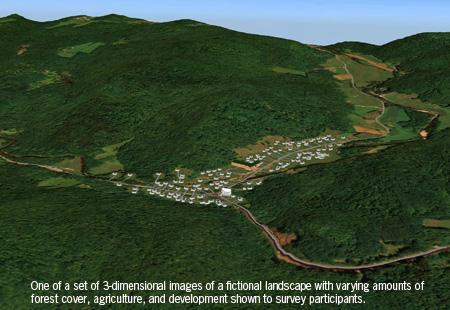Structured Decision Making for Land Use Planning in Vermont: Integrating Social and Ecological Objectives

The most serious threat to native wildlife species in the Northern Forest is conversion of natural land to development. Many wildlife species, such as black bear, bobcat, and fisher, require large areas to carry out their life cycles. Natural resource managers, tasked with managing wildlife, require techniques for predicting how much and where wildlife habitat is likely to be converted in the future.
NSRC researchers surveyed 1,505 Vermonters throughout 251 towns to determine their "acceptability" of alternative landscapes with different human population sizes and levels of development in a fictional town. Three-dimensional simulations of landscapes shown to participants varied in amounts of forest cover, agriculture, and development.
On average, Vermonters were willing to accept landscapes with 9.1% development, but this varied by town. This estimate is 68% higher than actual levels for development in 2000 (5.4%). Respondents indicated that management action to curb development was appropriate at 9.4% development. Management at local, regional, and state levels was considered acceptable for curbing development while federal level management of development was considered unacceptable. Given a scenario where development levels in towns throughout Vermont depicted “acceptable” levels, Vermont would lose 16,753 km2 in forestland and 1,038 km2 in farmland. Average occupancy rates would decline by 15.9% for black bear and 3.1% for bobcats. Average occupancy rates for fisher would increase by 9.0%. This study provides a method for linking development standards within a town with wildlife occurrence and helps to bring wildlife to the table in local town planning efforts.
